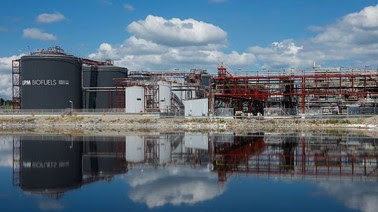UPM Lappeenranta biorefinery marks five years of operation
Type of post: NEWS.
The UPM Lappeenranta biorefinery started
commercial production in Lappeenranta (Finland) five years ago. The facility uses crude tall oil (byproduct
from pulp and paper manufacturing) to produce through hydrotreatment renewable fuels that decrease
emissions and mitigate climate change.
Press release: “Five years at the forefront of
biofuel development”,
13/1/2020.
Related posts:
- “UPM
Lappeenranta Biorefinery”, 26/2/2015.
- “The
Environmental Impact Assessment for the biorefinery project of UPM in Kotka is
completed”, 12/10/2018.
Figure 1. UPM Lappeenranta biorefinery marks
five years of operation (extracted from the press release)
UPM built the biorefinery, which cost 179 M€,
without any public investment subsidies. The construction started in summer
2012 and the foundation stone was laid in November of the same year. The works employed
nearly 200 people for approximately two years and now UPM Biofuels employs 100
people directly and around 150 people. Today, the facility produces
approximately 160 million litres of renewable biofuels and chemicals each year.
Those chemicals replace fossil-based raw materials in various plastics and adhesives
used, for example, in packaging and construction materials.
The greenhouse gas emissions of UPM BioVerno diesel
are over 80% lower than those of fossil-based diesel fuels. When used to
produce plastics, 1 ton of UPM BioVerno naphtha saves about 3 tons of CO2
compared to use of fossil-based raw materials. According to the press release, the
annual production of the UPM Lappeenranta biorefinery reduces the yearly GHG
emissions equivalent of roughly 150,000 cars on average.





